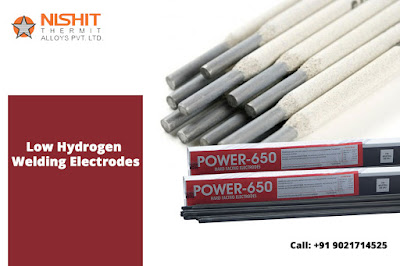Aircraft
repair and fabrication of structural components and high temperature components
including exhaust systems and ducting components often calls for NADCAP
approved welding.
Gas
welding
A
fuel gas such as acetylene or Low Hydrogen Welding Electrodes is mixed inside a welding torch with oxygen to produce a flame with a
temperature of approximately 6,300 degrees F. (3,482 degrees C). This fire is
used to melt the materials to be welded. A filler rod is melted into the puddle
of molten metal to reinforce the weld. When highly-reactive metals such as
aluminum are gas vented, they must be covered with flux to exclude oxygen from
the molten alloy and keep oxides from forming which could decrease the strength
of the weld.
Shielded
Metal Arc Welding (SMAW)
This
method is the most familiar and common type and is known in the trade as stick
welding. A metallic wire rod coated with a welding pattern is clamped in an
electrode holder connected to the power source with a heavy electrical cable.
The metal to be welded is also attached to the power source. The electrical
power is supplied to the work in a very low voltage and high current and might
be either AC or DC, depending on the type of welding being performed. An arc is
struck between the rod and the work and produces heat in excess ofF, which
melts both the substance and the rod. As the surface melts, it releases an
inert gas which shields the molten puddle from oxygen in the air and prevents
oxidation. The molten level covers the weld and hardens to an slag cover that
protects the weld bead as it cools. This slag must be chipped off to examine
the weld.
Gas
Metal Arc Welding (GMAW)
This
method of welding was formerly called Metal Inert Gas (MIG) welding and has
been an improvement over stick welding because an uncoated wire electrode is
fed into the torch and an inert gas such as argon, helium, or carbon dioxide
flows out round the wire to protect the puddle from oxygen. The power supply
connects between the torch and the job, and the arc produces the intense heat
needed to melt the work and the electrode. Low-voltage highcurrent DC is used
almost exclusively with GMAW welding. GMAW is used more for large-volume
production work than for aircraft repair.
Gas
Tungsten Arc Welding (GTAW)
Here
is the form of electric arc welding which fills the majority of the needs in
aircraft maintenance. It's more commonly known as Tungsten Inert Gas (TIG)
welding and by the trade names of Heliarc or Heliweld. These trade names were
derived from the fact that the inert gas originally used was helium.
Rather
than using a consumable electrode such as is used in both of the other two
methods we've discussed, the electrode in TIG welding is a regular rod. (In
earlier procedures using this form of welding, a carbon electrode was used, but
it has been replaced almost exclusively with tungsten.)
The
250+ Glass arc between the electrode and the job melts the metal at 5,432
degrees F, and a filler rod is manually fed into the molten puddle. A stream of
inert gas such as helium or argon flows out of the torch and envelopes the arc,
thereby preventing the formation of oxides in the puddle.
The
versatility of TIG welding is significantly increased from the power source
that is used. Direct current of either polarity or alternating current may be
used.


No comments:
Post a Comment